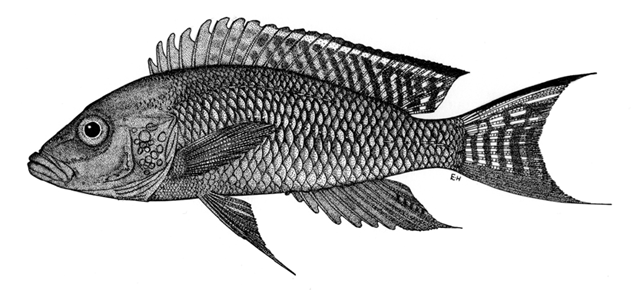|
Dorsal spines (total): 18-20; Dorsal soft rays (total): 8-10; Anal spines: 5-7; Anal soft rays: 5-7; Vertebrae: 30-31. Diagnosis: interorbital width 14.8–22.1% HL; preorbital depth 11.8–16.9% HL; caudal peduncle depth 11.3–13.2% SL; predorsal fin length 29.2–34.0% SL; preorbital depth 11.8–16.9%; HL; 6-9 gill rakers; 33–35 scales in longitudinal series; no scales on occiput; no scales on paired fins; no ctenoid scales on dorsal and anal fins; 2 scales between upper and lower lateral lines; 16 scales around caudal peduncle; cephalic pits present; 13 pectoral fin rays; 8-10 dorsal soft rays; 4-8 (mode 8) canines in upper and 4-7 (mode 6) in lower on anterior part of dental arcade; pronounced markings on dorsal and caudal fins; distinct pattern on unpaired fins; no markings on operculum; no bars on body; no conspicuous spots on scales; juveniles drab grey-brown with bluish dorsal and anal fins and vertical bars on body (Ref. 74422).
Description: 2 outer canines on both jaws enlarged, middle 2 smallest; dentigerous arm of premaxilla straight; 5-6 tooth rows in upper jaw, anteriorly reducing to a single row half way along the jaw, 32-38 outer row teeth including canines; 5–6 tooth rows in lower jaw, reducing to a single row approximately 2/3 along jaw, 27 outer row teeth; mouth terminal, isognath; gill rakers slender, concentrated near posterior end of lower arch and decreasing in size towards anterior end of arch, marked with small dark spots, sometimes 1-2 reduced at lower end of arch, sometimes one or several bifid; no scales on cheek, preoperculum and between eye and dorsal margin of preoperculum; 8-15 cycloid opercular scales, variable in size but smaller than flank scales; no scales on occiput; cycloid scales on nape, deeply embedded, varying from a few around origin of dorsal fin to fully covered; 5-10 small, cycloid scales between pectoral and pelvic fins, difficult to distinguish; small, cycloid scales between upper lateral line and origin of dorsal fin, often covered by skin; small cycloid scales on chest and belly; urogenital area with small, ctenoid scales; chest scales smallest; ctenoid scales on flank; dorsal fin with scaly sheath, few cycloid scales between soft rays, less between spines; anal fin with scaly sheath, few cycloid scales between rays, more than on dorsal fin; no scales on pectoral and pelvic fins; caudal fin with small ctenoid scales, mostly on rays, covering about on average anterior 75% of tail, larger specimens tend to have larger part of tail covered with scales, scales on outer rays range in adults up to past posterior end of middle rays; 33-35 scales in longitudinal series; 15-37 canal scales in total; 16-28 scales in upper lateral line, 13-26 canal scales in upper lateral line (76-100 % of all scales in upper lateral line, median 20, 91%); 8-18 scales in lower lateral line, 2-11 canal scales in lower lateral line (13-100 % of all scales in lower lateral line, median 6, 54 %); 2 scales between upper and lower lateral line; scales without canal segments in between canal scales pitted; anterior to canal scales in lower lateral line, pitted scales generally extended almost up to operculum; positive relationship between standard length and number of scales in upper lateral line, and number of canal scales in lower and upper lateral lines; lower and upper lateral lines overlap in specimens >51 mm; 1st pelvic fin ray longest; caudal fin lunate; 1st spines of dorsal and anal fins small; anal filament on average 2.5 % longer than dorsal fin filament; dorsal fin margin posterior to 6th spine straight; lower pharyngeal jaw about as wide as long; dentigerous area covered with slender, pointed, unicuspid teeth, anteriorly slightly recurved, posterior rows straight and enlarged; post-lachrymal infraorbital bone series absent; free neuromast papillae on infraorbital lateral line system; suborbital dermal depression forming thin but distinct groove; row of more or less contiguous cephalic pits with papillae runs from pore posterodorsal of orbit to pore anteroventral of orbit; papillae clearly visible in some specimens, tiny or absent in others; many epidermal papillae around pectoral, behind and on pelvic fin, around genital pore and posterior edges of operculum and preoperculum in specimens of Tembo Rock, slightly or not at all present in specimens from Muzungu Beach (Ref. 74422).
Coloration: Live specimens: body dark, grey to almost black, larger specimens lighter; caudal margins of scales brown, producing checkered pattern on body; between first 4 spines of dorsal fin margin of membrane yellow (lappets); blue eye and blue stripe under eye; stressed individuals rarely show bands on body; no trace of opercular markings; conspicuous black and white bands along dorsal margin of tail and posterior margin of dorsal fin (submarginal white or transparent); vertical bands on dorsal and caudal fins (Ref. 74422). Preserved specimens: vertical bands on fins less visible, no colour on iris; no suborbital stripe (Ref. 74422).
Juveniles: vertical bands on fins less clear or not visible, especially on tail; smallest young(up to about 20 mm) observed in natural habitat with bluish fins and light vertical bars, with dark and light bars, in specimens of 14–25 mm body grey-brown; tail emarginate, no filaments on caudal, dorsal and anal fins; pelvic fin blackish, dorsal fin margin black; tail 10-40% covered with scales, no scales on other fins, operculum scaled, no scales on nape and occiput (Ref. 74422). |

